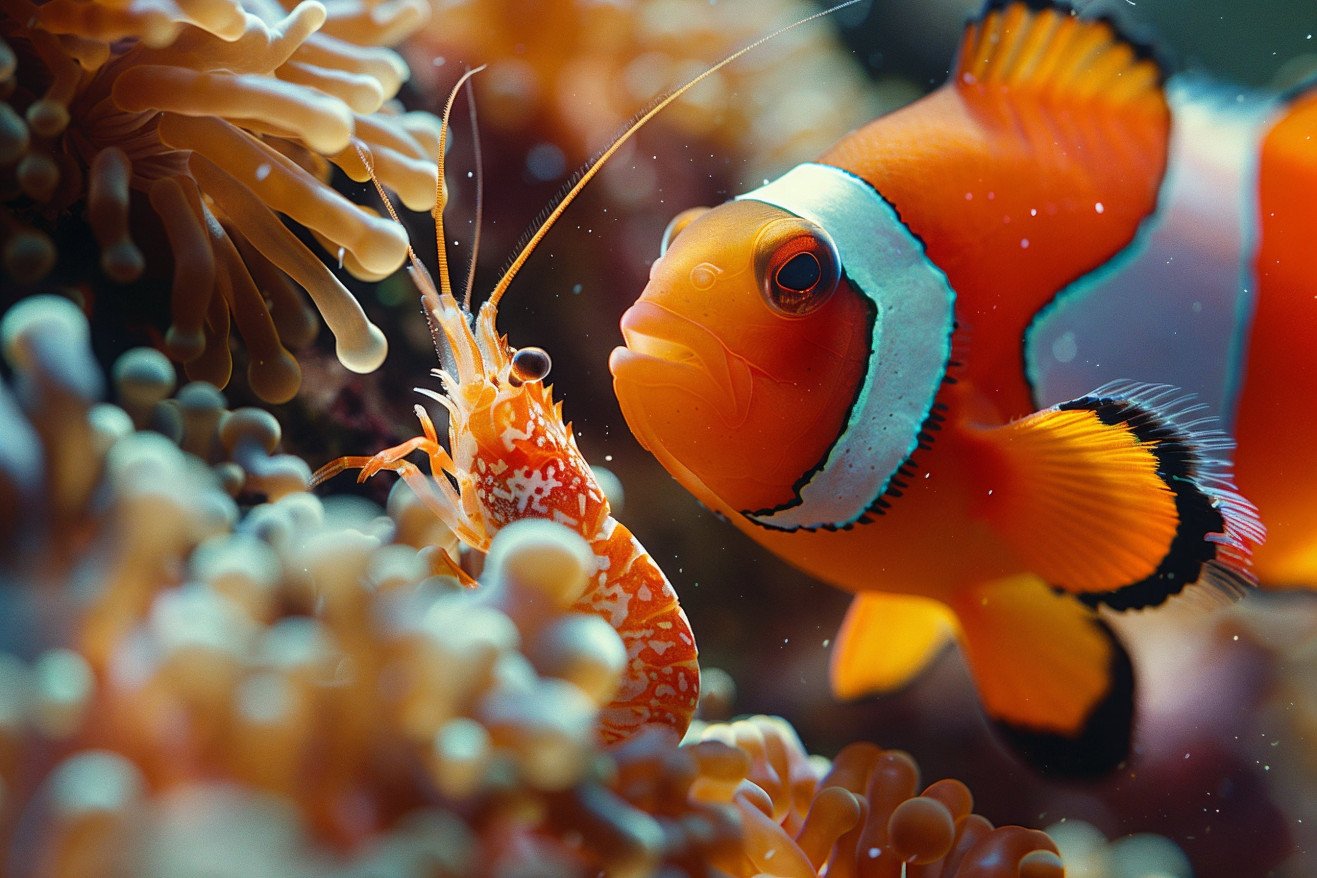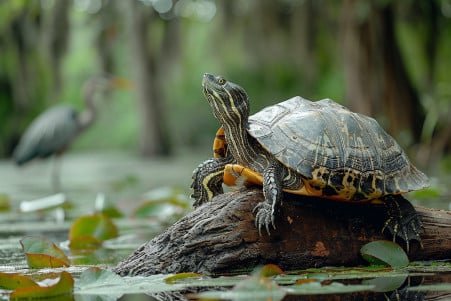What Do Shrimp Eat? An Overview of Shrimp Predators and Marine Food Webs
20 March 2024 • Updated 19 March 2024

From the deep sea to the shallows, shrimp have a wide range of predators. Larger fish, seabirds, marine mammals such as dolphins and whales, and other crustaceans are just a few examples of the many animals that eat shrimp. Even humans have a huge impact on shrimp populations due to the large amount of shrimp that we catch and eat, which shows just how important shrimp are as a food source in marine ecosystems.
To learn more about the predators that eat shrimp and the role that shrimp play in their diets, we can look at marine biology and ecological research that has been done on these predator-prey relationships. This research shows how important shrimp are in the food web and how the animals that eat them can impact the ocean.
Looking at this research can help us learn more about the complexities of marine ecosystems and the balances that are necessary to maintain biodiversity in the ocean.
What are the predators of shrimp?
Shrimp Are Eaten by a Wide Variety of Predators
Shrimp play an important role in the food chain, and they are eaten by a wide variety of predators, from small fish to large marine mammals.
According to What Eats, shrimp are eaten by a number of different animals, including sharks, which use their sharp teeth to catch shrimp, and eels, which use their sense of smell and sharp teeth to hunt shrimp. Shrimp are also eaten by a number of different types of fish, including filter-feeding fish like tuna and mackerel and ambush predators like cod.
The size and location of shrimp have a big impact on how vulnerable they are to predators. For example, shrimp that live in open water or near the surface are more likely to be eaten by predators that rely on their vision, such as snappers and birds like herons and egrets. Meanwhile, larger crustaceans like lobsters and crabs catch shrimp with their claws.
One of the best-known predators of shrimp is whales, especially baleen whales. As a study published in Nature and reported by Smithsonian explains, baleen whales consume huge amounts of shrimp, with some species eating as much as 16 tons of shrimp a day.
This massive consumption shows just how important shrimp are to marine life, connecting the smallest plankton to the ocean’s top predators. As shrimp are increasingly recognized as a keystone species in marine and freshwater ecosystems, their role in maintaining a healthy predator-prey balance becomes more and more clear.
Shrimp Predation in Marine Ecosystems
Shrimp are an important part of marine ecosystems, serving as both predator and prey. Their presence is necessary for the balance of complex food webs, and their predation has important ecological impacts.
As one study cited on PubMed demonstrates, the relationship between shrimp abundance and predator populations is complex. It shows that shrimp populations are higher in areas with more habitat complexity and refuge availability, which leads to lower fish populations. This complex relationship shows how important shrimp are to population dynamics and the success of other marine species, including those that eat them.
The predator-prey relationship also has indirect impacts, including on nutrient cycling and ecosystem productivity. For example, A report by NOAA Fisheries blames the collapse of the northern shrimp population in the Gulf of Maine on a combination of warming temperatures and an increase in predation by longfin squid.
These changes can have cascading impacts on the ecosystem, changing the populations and behaviors of other species, and ultimately impacting the overall health and biodiversity of marine ecosystems.
Similarly, a study published on PMC shows that at semi-intensive shrimp farms, the predation risk posed by falcons impacts shorebird behavior and habitat use, showing how important it is to understand these relationships to fully understand ecosystem dynamics.
When you consider the complexity of marine ecosystems, it becomes clear that shrimp are more than just prey; they are important contributors to the health and function of marine ecosystems, impacting the lives of their predators and the environment as a whole.
Shrimp’s Amazing Anti-Predator Adaptations
In the harsh world of the ocean, where it’s truly a case of eat or be eaten, shrimp have evolved some pretty amazing anti-predator adaptations. A study in the Journal of Crustacean Biology found that the Australian freshwater prawn, Macrobrachium australiense, has complex anti-predator behaviors.
In order to minimize their risk of predation, the prawns change their refuge-seeking behavior, hiding during the day when predators are most active. Their fast escape response, which is a type of ‘tail-flip’ escape mechanism, is an example of their amazing ability to avoid being eaten.
In addition to this, shrimp also use a classic anti-predator adaptation: camouflage. By blending in with their surroundings, they can reduce their detectability to predators. By combining this with their tendency to seek out areas with lots of vegetation to hide in, shrimp can greatly reduce their risk of being detected and eaten.
Moreover, a study in PMC explains that the mantis shrimp has not only evolved impressive offensive weapons but also shock-absorbing armor, which protects them from conspecifics during ritualized combat. This shows that defense mechanisms can have a dual purpose, acting as both a defense and impacting an animal’s social life.
These defense mechanisms are essential to the survival of shrimp and show a fine balance between the need to forage for food and the need to avoid predators. The success of these adaptive behaviors is important because it allows shrimp to continue to fulfill their role in the marine food web, which in turn impacts the economic success of the fisheries that rely on them.
Economic Implications of Shrimp Predation in Fisheries
The complex relationships within marine ecosystems have real-world socioeconomic impacts, especially in the fisheries industry. Predation on shrimp, which is one of the most important species for fisheries, can have a major impact on shrimp populations, which in turn can impact the amount of shrimp that can be harvested and the economic well-being of coastal communities.
For example, a paper in ScienceDirect notes the far-reaching economic implications of the shrimp fishery in Newfoundland and Labrador, including the way shrimp fishing supports local economies by enabling the provision of infrastructure and services.
It is important for management to find ways to minimize the effects of natural predation and ensure the sustainability of shrimp fisheries. A study in PNAS shows that ecological disruptions, such as coastal hypoxia, which can impact shrimp populations, can also impact seafood prices and therefore the economic sustainability of fisheries. The ability to adjust management practices to meet these environmental challenges is important for the long-term sustainability of the industry.
In addition, a study in Marine and Coastal Fisheries shows that the habitat changes caused by hypoxia can lead to large annual declines in shrimp catches, which means that expectations for the economic benefits of the fishery and fishing practices need to be reevaluated.
It is clear that maintaining the sustainability of shrimp fisheries in the face of the challenges of natural predation will require a deep understanding of these relationships and a willingness to practice adaptive management that prioritizes both ecological and economic concerns.
Understanding the Nutritional Mysteries of Shrimp Predation
Shrimp predators use a range of tactics to choose their prey, including prey size, seasonality, and habitat complexity.
For example, a paper from ScienceDirect on the deep-sea penaeid shrimp Metapenaeopsis andamanensis found that the species exhibited a strong carnivorous feeding mode, but that the species’ diet changed based on the season and the maturity of the shrimp. As a result, predators need to adjust their foraging tactics to account for the changing availability of shrimp.
The importance of shrimp as prey is many-sided and meaningful. In the Annual Review of Marine Science, scientists noted that marine predators may choose their prey based on nutritional quality rather than energy content when viewed through the lens of nutritional ecology. This means that predators may choose to eat shrimp, which are high in essential fatty acids, because of their nutritional value rather than just their energy content.
Habitat changes and seasonal variations have a major impact on shrimp predation. For example, a paper from PMC found that predator-prey interactions evolve based on traits like hunting mode and prey mobility, which are in turn influenced by environmental factors.
This intricate interaction of evolution highlights the significance of comprehending the dietary viewpoints and feeding habits of shrimp predators, which can then be utilized to guide more focused conservation and management practices in marine ecosystems.
The Shrimp That Hides: The Importance of Shrimp in Marine Ecosystems
In the intricate mosaic of marine life, shrimp play a crucial role as a keystone species, feeding a wide range of predators and helping to uphold the structure of food webs.
This article has shown how important shrimp are in both oceanic and freshwater ecosystems. From the tiniest fish to the largest whales, many species rely on the presence of shrimp for their survival.
However, the impact of shrimp on the animals that eat them goes beyond just being a food source. Shrimp also help determine the balance of ecosystems and can impact the reproductive success and population sizes of the animals that eat them.
Shrimp have developed various strategies to evade predators, from blending into their surroundings to swift movement, showcasing a complex interplay between their instinct for survival and the dietary requirements of their predators. This interplay illustrates the co-evolution that has transpired between hunters and the hunted in the marine ecosystem.
In addition, the economic impact of shrimp predation on fisheries is not to be underestimated. Both local fishing communities and the global seafood industry rely on the ability to sustainably catch shrimp, which makes the need for effective management of shrimp populations clear.
As we conclude this exploration, the complex network of life in the ocean becomes increasingly evident. Shrimp, serving as both hunter and food, are a vital component of this network, and their role illustrates the complexity and delicacy of marine ecosystems.


